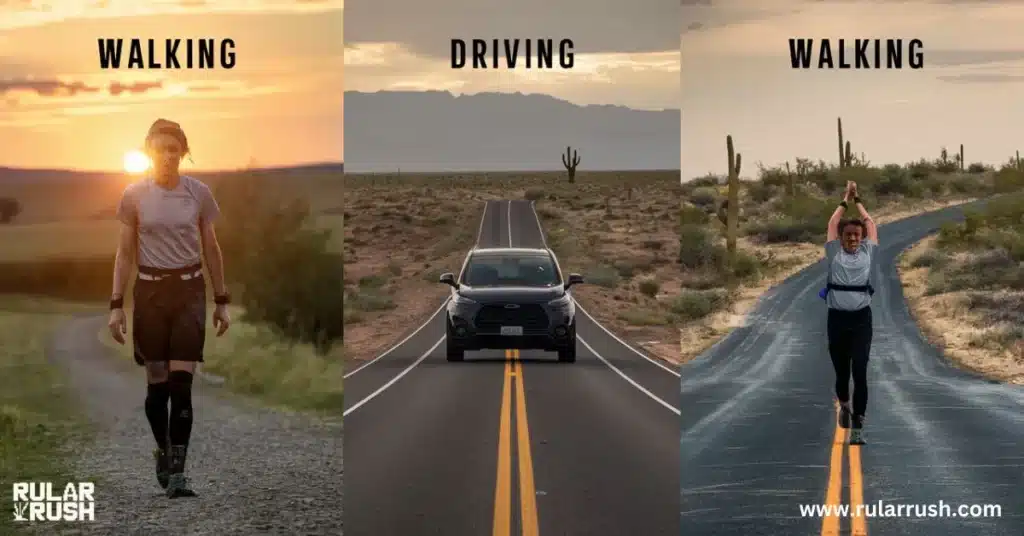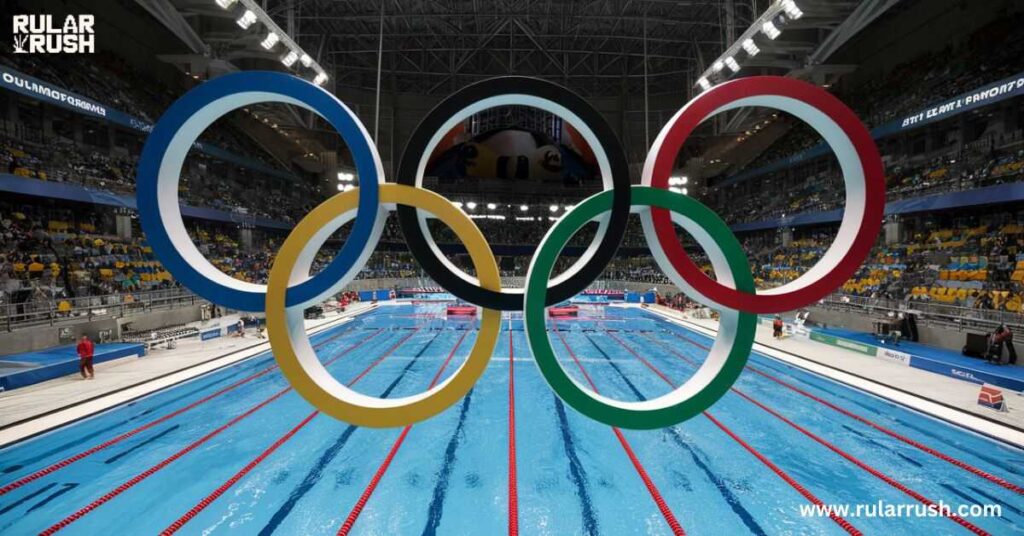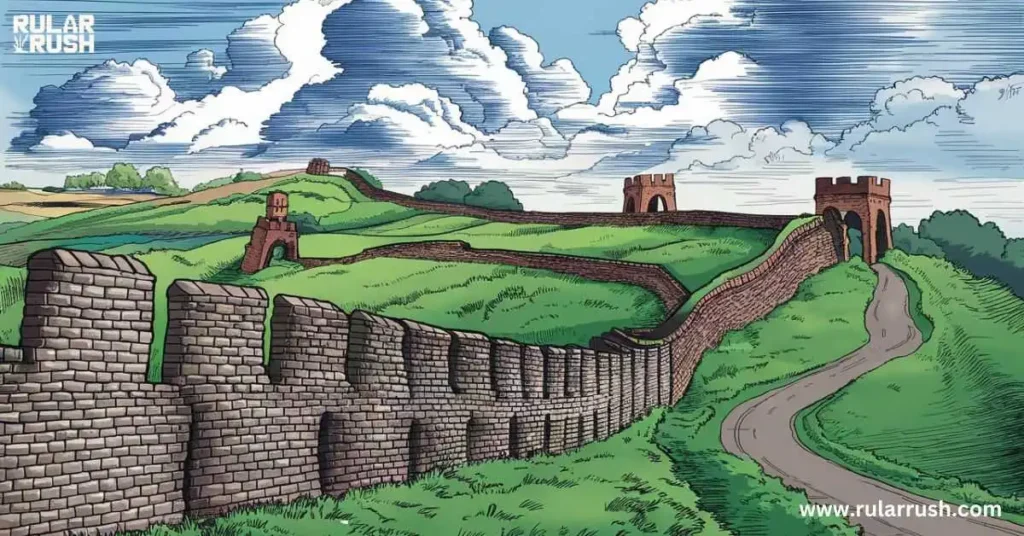- How Far is 50 Miles? stretches beyond just numbers. To put it in perspective, imagine walking 50 miles which takes about 16-17 hours at a steady pace, or driving 50 miles on a highway which typically requires 50 minutes. It’s twice the length of a marathon, 40 times around a Kentucky Derby track, and matches the entire length of the Panama Canal. For city dwellers, it’s like doing 17 round trips of the High Line in New York City or circling Central Park 4.5 times. Nature enthusiasts might compare it to scaling Mauna Loa 20 times or traversing two-thirds of Hadrian’s Wall. This distance shapes everything from daily commutes to athletic achievements.
The Human Experience of 50 Miles

Before diving into our comparisons, let’s establish some basic facts about covering 50 miles:
Walking 50 Miles:
- Average walking speed: 3-4 mph
- Total time needed: 16-17 hours
- Calories burned: ~4,000-5,000
- Steps taken: ~100,000
Driving 50 Miles:
- Highway speed (65 mph): ~46 minutes
- City driving: 1.5-2 hours
- Fuel consumption: ~2 gallons (average car)
- Electric vehicle range: Typically uses 25-30% of full charge
“Distance is not just a number—it’s a journey, a challenge, and sometimes a daily reality.” – Ultra-runner Scott Jurek
12 Striking Real-World Comparisons
Athletic Achievements
1. Double Marathon Distance

A standard marathon spans 26.2 miles, making 50 miles nearly twice the distance. Consider these facts:
- World record marathon time: 2:01:09 (Eliud Kipchoge)
- Ultra-marathoners typically take 7-12 hours for 50 miles
- Only 1% of the global population has completed a marathon
2. Kentucky Derby Times

The Kentucky Derby track at Churchill Downs measures 1.25 miles. You’d need to:
- Run the track 40 times to reach 50 miles
- Current track record: 1:59.40 (Secretariat, 1973)
- Equivalent to watching the Derby 80 times back-to-back
3. Olympic Pool Length x 1,609

An Olympic swimming pool is 50 meters long:
- You’d need to swim 1,609 lengths
- Michael Phelps’ typical training session: 80-100 lengths
- Equal to about 20 typical swim training sessions
Natural Landmarks
4. Mauna Loa’s Height Multiplied

Hawaii’s massive volcano stands at 13,681 feet (2.6 miles):
- 50 miles equals 19.2 times its height
- Would stack higher than the distance to the ozone layer
- Represents the height of 158 Empire State Buildings
5. Grand Canyon Width Comparison
The Grand Canyon averages 10 miles in width:
- 50 miles equals 5 Grand Canyon widths
- Could fit the entire Las Vegas Strip 12.5 times
- Spans the distance of 277 football fields
Here’s a comparison table of natural landmarks:
| Landmark | Actual Distance | How Many Equal 50 Miles |
|---|---|---|
| Mauna Loa Height | 2.6 miles | 19.2x |
| Grand Canyon Width | 10 miles | 5x |
| Mount Everest Height | 5.5 miles | 9.1x |
| Death Valley Length | 130 miles | 0.38x |
6. Panama Canal Journey

The Panama Canal stretches almost exactly 50 miles:
- Takes ships 8-10 hours to traverse
- Saves 7,872 miles vs. circumnavigating South America
- Engineering marvel completed in 1914
Urban Landscapes
7. New York High Line Times 17

The High Line spans 1.45 miles:
- Need 34.5 round trips to reach 50 miles
- Equivalent to passing 850 art installations
- Walking past 100,000 plants
8. Central Park Circuit x 4.5

Central Park’s main loop measures 6.1 miles:
- 8.2 full circuits equal 50 miles
- Passes 21 playgrounds per circuit
- Encounters 58 different species of trees
9. Common City-to-City Distances

Real 50-mile city pairs include:
- San Francisco to San Jose
- London to Cambridge
- Tokyo to Mount Fuji
Historical Monuments

10. Hadrian’s Wall Portion
The ancient Roman wall spans 73 miles:
- 50 miles covers about 68% of its length
- Passes 80 milecastles (Roman fortifications)
- Crosses through 6 English counties
11. Great Wall of China Perspective

While the entire wall spans thousands of miles, workers typically completed about 50 miles per year during peak construction:
- Represents one year of ancient Chinese engineering
- Contains roughly 25,000 individual stone blocks
- Required about 1,000 workers to build this length
12. Appalachian Trail Segment

The full trail spans 2,190 miles:
- 50 miles equals about 2.3% of the total trail
- Typically takes hikers 3-4 days to complete
- Crosses approximately 10-12 mountains
Practical Applications of Understanding 50 Miles
Emergency Preparedness
Understanding a 50-mile radius helps with:
- Evacuation planning (standard nuclear evacuation zone)
- Natural disaster response areas
- Emergency supply chain logistics
Common 50-Mile Scenarios
Commuting Impact:
- 3.3% of Americans commute 50+ miles each way
- Annual fuel cost: ~$2,500-3,000
- Time spent annually: ~500 hours
Wildlife Migration:
- Gray wolves typically patrol 50-mile territories
- Monarch butterflies can travel 50-80 miles per day
- Bird migration patterns often use 50-mile rest stops
Here’s a breakdown of 50 miles in different measurements:
| Unit | Equivalent to 50 Miles |
|---|---|
| Kilometers | 80.47 |
| Meters | 80,467 |
| Feet | 264,000 |
| Yards | 88,000 |
| Nautical Miles | 43.4 |
Modern Context and Technology
Transportation Evolution
Electric Vehicle Range:
- Most EVs can travel 50 miles using 25-30% battery
- Fast charging stations typically placed every 50 miles
- Represents optimal commuter vehicle range
Drone Operations:
- Commercial drones: 50-mile range requires special FAA waiver
- Military drones: Standard patrol radius
- Delivery drones: Future target range for advanced systems
Digital Perspective
5G Network Coverage:
- Base station typical range: 30-50 miles
- Signal strength degradation: 0.25% per mile
- Network planning uses 50-mile hexagonal cells
Environmental Impact of 50 Miles
Carbon Footprint
Average CO2 emissions for 50 miles:
- Gas car: ~44 pounds
- Electric vehicle: ~20 pounds
- Bus: ~15 pounds per passenger
- Train: ~10 pounds per passenger
Terrain Variations
How different terrains affect 50-mile journeys:
| Terrain Type | Walking Time | Driving Time |
|---|---|---|
| Flat Road | 16-17 hours | 50 minutes |
| Mountains | 20-24 hours | 75 minutes |
| Desert | 18-20 hours | 45 minutes |
| Snow | 22-26 hours | 90 minutes |
Real-World Applications
Popular 50-Mile Challenges
- JFK 50 Mile Ultra Marathon
- Oldest ultramarathon in America
- Average completion time: 11-13 hours
- Success rate: 75%
- Military Fitness Tests
- Special Forces qualification requirements
- 20-hour maximum time limit
- Full gear weight: 35-45 pounds
Professional Perspectives
“Fifty miles isn’t just a distance—it’s a milestone that separates casual athletes from endurance specialists.” – Dean Karnazes, Ultra-marathon Runner
How different professionals view 50 miles:
- Truck Drivers: “A short haul”
- Marathon Runners: “The next challenge”
- Farmers: “Daily coverage area”
- Commuters: “Life-changing distance”
Conclusion: Visualizing 50 Miles
Understanding how far 50 miles extends helps in:
- Planning travel time
- Setting fitness goals
- Making location decisions
- Environmental awareness
- Emergency preparedness
Whether you’re walking, driving, or flying, 50 miles represents a significant distance that impacts daily life in countless ways. From ancient monuments to modern technology, this distance continues to shape human experience and achievement.
FAQs About 50 Miles
Q: How long does it take to bike 50 miles?
A: Average cyclists complete 50 miles in 3-5 hours, depending on terrain and fitness level.
Q: What’s the fuel cost for driving 50 miles?
A: At current average prices ($3.50/gallon), approximately $7-10 for most vehicles.
Q: Can you walk 50 miles in a day?
A: Yes, though it typically takes 16-17 hours and requires significant physical preparation.
Q: How many calories does walking 50 miles burn?
A: Approximately 4,000-5,000 calories for an average adult.
Q: What’s the average 50-mile commute time?
A: 45-90 minutes each way, depending on traffic and route conditions.
By understanding these comparisons and real-world applications, you can better grasp just how far 50 miles extends and what this distance means in various contexts of modern life.
Must Read :https://rularrush.com/things-that-are-20-meters-long-big/

Elizabeth is an experienced blogger at “Rular Rush,” specializing in delivering precise and insightful content on various measurement topics. With a passion for simplifying complex concepts, she brings clarity and depth to each post, making technical information easy to understand for readers worldwide.






